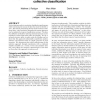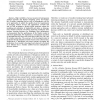499 search results - page 66 / 100 » Learning Through Telemedicine Networks |
ICDM
2007
IEEE
13 years 11 months ago
2007
IEEE
Active inference seeks to maximize classification performance while minimizing the amount of data that must be labeled ex ante. This task is particularly relevant in the context o...
ICC
2009
IEEE
14 years 2 months ago
2009
IEEE
— High variability of access resources in heterogenous wireless networks and limited computing power and battery life of mobile computing devices such as smartphones call for nov...
TVLSI
2010
13 years 2 months ago
2010
Clock network is a vulnerable victim of variations as well as a main power consumer in many integrated circuits. Recently, link-based non-tree clock network attracts people's...
IPCCC
2007
IEEE
14 years 1 months ago
2007
IEEE
Key management is the cornerstone for secure communication in sensor networks. Researchers have recently developed many techniques to setup pairwise keys between sensor nodes. How...
ICAC
2006
IEEE
14 years 1 months ago
2006
IEEE
Network resources will always be heterogeneous, and thus have different functionalities and programming models. This adversely affects interoperability. Seamless Mobility is one e...


